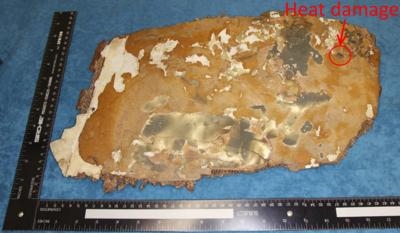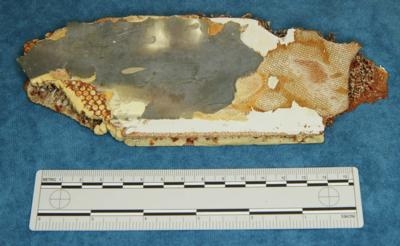Fri, Sep 23, 2016
Has Not Yet Determined If The Pieces Are From MH370, Or Even A Boeing 777
Two items of fibreglass-honeycomb composite debris were recovered near Sainte Luce on the south-east coast of Madagascar, having reportedly washed ashore in February 2016. They were hand-delivered to the Australian Transport Safety Bureau on September 12, 2016, and were initially reported in the media as being burnt.

The ATSB reports that no manufacturing identifiers, such as a part numbers or serial numbers were present on either item, that may have provided direct clues as to their origin. At the time the report was issued, the items had not been identified and work in this respect is ongoing.
A dark grey coloration was present on a significant proportion of both sides of each item. Detailed examination of these areas showed that the colour related exclusively to a translucent resin that had been applied to those surfaces.
A cross section through the panel showed a clear delineation between the dark resin and the other surface coatings without any evidence of gradual transition. The lighter grey surface areas resulted from a thinner film of the same resin applied over an off-white background. This confirmed that the dark color of the coating was an inherent property of the resin, and not the result of exposure to heat or fire.

Despite no evidence of overall gross heat damage, two small (<10mm) marks on one side of the larger item and one on the reverse side were identified as damage resulting from localized heating. A burnt odour emanating from the large item was isolated to these discrete areas. The origin and age of these marks was not apparent. However, it was considered that burning odours would generally dissipate after an extended period of environmental exposure, including salt water immersion, as expected for items originating from 9M-MRO.
Work is ongoing to determine the origin of the items, specifically, whether they originated from a Boeing 777 aircraft.
The dark grey colouration on the outer surfaces of the items related to an applied resin and was not the result of exposure to heat or fire. Three small marks on the larger item were indicative of localized heating. The age and origin of these marks was not apparent.
(Source: ATSB Report)

More News
Minimum Friction Level The friction level specified in AC 150/5320-12, Measurement, Construction, and Maintenance of Skid Resistant Airport Pavement Surfaces, that represents the m>[...]
Aero Linx: Airpower Museum The APM owns 30 acres on Antique Airfield, including the south half of the N-S runway. It consists of three hangars, an annex, and a library. The museum >[...]
Patient Told The First Responders That The “Man Who Was In The Plane Was Flying At The Time Of The Accident And Had Overshot The Runway They Were Attempting To Land On.&rdquo>[...]
Klyde Just Can't Believe This Has Gotten To This Point... FMI: www.klydemorris.com>[...]
Also: Duffy Wants $$$, KS Airports, Morningside U’s Aviation School, New Airstrip In ID After 6 were killed in a helicopter crash over the Hudson River, several US Representa>[...]
 ANN's Daily Aero-Term (06.02.25): Minimum Friction Level
ANN's Daily Aero-Term (06.02.25): Minimum Friction Level ANN's Daily Aero-Linx (06.02.25)
ANN's Daily Aero-Linx (06.02.25) NTSB Prelim: Champion 7ECA
NTSB Prelim: Champion 7ECA Classic Klyde Morris (From 06.10.22)
Classic Klyde Morris (From 06.10.22) Airborne 05.30.25: Anti-Helicopter Bill, PW Strike Done, All-Electric Bristell
Airborne 05.30.25: Anti-Helicopter Bill, PW Strike Done, All-Electric Bristell





